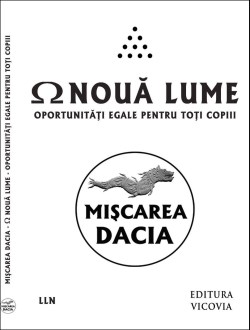 Vă invit să vă alăturaţi grupului Facebook Mişcarea DACIA, ce-şi propune un alt fel de a face politică!
Vă invit să vă alăturaţi grupului Facebook Mişcarea DACIA, ce-şi propune un alt fel de a face politică!Citiţi partea introductivă şi proiectul de Program, iar dacă vă place, veniţi cu noi !
O puteţi face clicând alături imaginea, sau acest link
Posts Tagged ‘Anaximandru’
Apeiron
Hegel referred to the basic substance of the universe as “Geist”, a complex German word that expresses notions of both mind and spirit. Geist is dialectically evolving towards what Hegel called ‘the Absolute’ – God. The Absolute represents the complete control of the physical world by the mental. It is a state of Absolute Knowledge and Absolute Freedom. The Absolute understands itself perfectly. Hegel is often interpreted as an idealist, denying the existence of the physical, but in fact, like all Illuminists, he considered the physical and mental to be two aspects of a single substance.

However, he certainly regarded the mental as the dominant aspect of the single mind-matter reality – the dialectical process is all about bringing mind to its highest possible expression – and to that extent can be regarded as an idealist. Hence “Geist” is carefully chosen to emphasise the mental aspect.
There is no word that perfectly captures the nature of the basic substance of the universe: the arche, the first principle. The Ancient Greek philosopher Anaximander used the word “apeiron”, which is usually translated as “a substance without definition that gives rise to all things and to which all things return, a sort of primal chaos.”
Illuminists most usually use the word “Becoming” to describe the single fundamental substance of the universe. “Becoming” is technically an adjective rather than a noun, but Illuminists prefer this word over any other because it makes clear the difference between Illumination and the false religions of Being such as Christianity, Islam and Judaism.
“Becoming” emphasises the changing, dynamic nature of the universe, the evolutionary, dialectical aspect that drives the universe forwards and upwards. “Being” on the other hand is frozen, static, conservative, resistant to change. Mathematician Roger Penrose has proposed that there are three kinds of reality: physical, mental and mathematical, all connected in an unknown and deeply mysterious way. In fact there is only one reality, which presents itself in two ways: mind and matter.
Mathematics, it is true, is more than just a language created by the mind. It might be said to be a deep expression of Nietzsche’s Apollonian ordering principle that seeks to shape the Dionysian chaos. Mind and matter, if they are to avoid an existence of meaningless chaos, must have a strong core of order and organisation, a tendency to obey natural laws. That tendency will never be precise, but it will be reliable on average, hence the statistical emphasis of modern Quantum Theory.
Mind and matter both have mathematics built into them. Mathematics can be defined as the science of pattern. Mathematicians look for patterns in numbers and space, in the physical world and abstract worlds. The mind cannot help looking for patterns. Humans look at the clouds in the sky and start to see meaningful shapes. People have reported seeing the face of Jesus Christ on slices of toast. At all times, the mind tries to shape and pattern sensory data. All of this is mathematical in nature.
Baseball players, basketball players, American football players, soccer players and most other sportspeople engage in remarkable feats of intuitive mathematics. Think of the skill involved in catching a ball while on the run: the catcher is subconsciously calculating the speed of the ball, its trajectory, wind speed, his own speed, the conditions under his feet, the interception point, the orientation of his hands etc. The person involved may know nothing about mathematics as an academic subject, he might even be hopeless at the subject, yet he can solve this complex maths problem as he’s on the move without carrying out a single conscious calculation. Autistic savants can carry out prodigious calculations in their heads faster than professors can solve them with a calculator. These examples prove how deeply embedded in the psyche mathematics is.
The Ancient Greek philosopher Pythagoras – another great Illuminist (and the first to be identified with Illumination’s fundamental doctrine of the transmigration of souls) – claimed that numbers are the arche. He also said that a mathematical Law called Harmony controlled the universe. Pythagoras is associated with the mystical idea of the Music of the Spheres (also known as Musica universalis – universal music): the most beautiful and perfect music of all, which permeates the entire universe but can be heard only by God. Music is audible mathematics. It is the sound of the Apollonian order in the universe. It has such a powerful effect on us because it resonates with the mathematical intuitions buried within us. When we hear harmonies, we are listening to orchestrated numbers; we are directly experiencing universal order in the form of musical notes. Discordant music, jarring notes are the province of Dionysian disharmony.
Schopenhauer said that music was a “copy of the will itself” and there’s much truth in this. Illumination is a religion that holds mathematics in the highest regard and assigns to it an elevated status, but it is not a separate reality as Roger Penrose believes. It is part of the fabric of mind and matter. It is the language of the fundamental ordering principle.
Excerpted, page 161
© The Illuminati’s Secret Religion
Artwork by Joshua Hehe
Hyperian History Of The World (3rd Century)
“Hyperian History Of The World (3rd Century)
In the 3rd Century, the Hellenic world, centred on Alexandria, was awash in various, conflicting sects of Christianity, ranging from those more radical and more Jewish, to those more pagan, such as the Gnostic sects, as well as many other non-christian sects of Greek/Roman paganism. In the previous century, the religious element of these sects had taken precedence over any kind of intellectual, philosophical elements. But in the 3rd century, a great genius appeared in the world who would revive Greek philosophy and combine it with the religious sensibility of the time to produce a truly intelligent and intellectual religion. The Genius was Plotinus and his philosophical religion became known as Neoplatonism.
After travelling to Alexandria seeking philosophical wisdom, Plotinus came across a man called Ammonius Saccas, whose lectures on the philosophy of Plato so affected Plotinus that he immediately began studying under this new teacher. After many years of study under Ammonius Saccas, Plotinus began travelling around gaining further wisdom from Persian, Indian and Arab philosophers before finally settling in Rome towards the end of his life, where he spread his teachings around the great city.
Plotinus’s philosophical religion is basically the philosophy of Plato turned into a religion. Plotinus himself insisted that he was not creating anything new, but was rather producing the culmination of Plato’s philosophy. In the system of Plotinus, everything has its source in what he called The One. The One is essentially the arche, the source of everything. But for Plotinus, The One, as the source of everything, is very similar to Pythagoras’s concept of the point that contains all other points, i.e. The One is purely dimensionless and immaterial, yet contains within it everything else in the universe.
Plotinus’s system consists of a series of emanations starting from The One. The first thing that emanates from The One is The Nous, basically the same Nous as that of Anaxagoras. The Nous is the mind or the intellect of the universe, the thing that guides it and controls it. For Plotinus, the Nous contains within it all of the perfect Forms that Plato had spoken of. As the mind of the universe, the Nous knows everything about the universe and thinks all possible thoughts simultaneously.
The next emanation is the Psyche or the soul, emanating from the Nous. The Psyche is equivalent to Plato’s Demiurge. Whereas the Nous thinks everything simultaneously, the Psyche thinks slowly and as a linear process. The Psyche can access the Forms present in the Nous and use them to create the next emanation which is Nature, or the physical world, which is, as Plato said, an inferior copy of the Forms in the Nous. The Psyche is also split into two parts, firstly the upper part which is the World Soul, the collective soul of the world, and secondly, the lower part which takes the form of all the individual souls in the universe.
As these individual souls are only one emanation away from the physical world, Plotinus explains that these souls take the physical world to be true reality, when, in fact, True reality is mental rather than material, the true Forms in the Nous rather than the inferior copies of them in Nature. For Plotinus, the task of our souls is to leave behind the physical world and travel back up the emanations, firstly to the upper Psyche, or World Soul, then into the Nous itself where the True Forms are, and finally back to The One, which contains everything. This idea expands on Anaximander’s original concept that the universe begins as apeiron and shall return to apeiron.
Unfortunately, Plotinus’s religion, based on reason, rationality and mathematics, as well as the ideas of the greatest of geniuses of Ancient Greece, failed to take hold of Europe which, instead, adopted the absurd, irrational, faith-based version of Christianity which took over the Roman empire.
Of course, it is not too late to abandon the absurdity that is Christianity and revive the brilliant ideas of Plotinus, a religion which would far better have served the Romans and, indeed, the rest of the world. A religion based on reason, philosophy and mathematics is precisely what the world needs right now. The central idea can be summed up by Plotinus’s supposed last words: “Try to raise the divine in yourselves to the divine in the all.” If that’s not Hyperian, I don’t know what is.”
– Azure Circe – Hyperian

HIPERIENII
Secrets Of The Greenwood ·
„Deci, cum au început să înțeleagă universul, primii hiperieni? Cum au început să-l descifreze? Inițial, a fost constatarea că a existat un conflict între ceea ce era Observat de Simțuri cu ceea ce putea fi Conceput de Minte. Când Observăm lumea din jurul nostru, totul pare a fi Finit. Corpurile noastre sunt obiecte finite. Țara în care trăim este limitată de mare. Pământul însuși este limitat de spațiu. Totul pare să aibă o limită, o margine la care ceva se termină și altceva începe. Cu toate acestea, imaginați-vă succesiunea Numerelor în Mintea dvs., pornind de la Zero. Cât de departe ai putea să te duci? Ai ajunge vreodată la o limită? Se pare că, indiferent cât de mare Număr atingeți, puteți oricând să adăugați altul și să continuați. Astfel, este posibil să concepem Infinitul în Mintea noastră. Dacă totul în jurul nostru este Finit, cum este posibil să concepem Infinitul?
Să presupunem că dorim să determinăm dacă universul este finit sau infinit. Trebuie să ne bazăm pe Percepțiile noastre despre Finit? Sau ar trebui să ne folosim de concepția noastră despre infinit? Dacă ne bazăm pe Percepție, la Observație, nu vom răspunde niciodată la întrebare. Pentru a determina prin Observație dacă Universul este sau nu finit, ar trebui să observăm o limită la marginea universului. Pentru că toate lucrurile finite sunt limitate. Dacă nu se observă nicio limită, acest lucru nu dovedește că universul este infinit, pentru că putem spune întotdeauna că nu am observat suficient de departe, granița, dacă este acolo, ar putea fi mai departe decât am observat în prezent. Astfel, Observarea ar putea continua pe o perioadă nedeterminată, iar lipsa de Observare a unei limite nu ar fi niciodată o dovadă a inexistenței ei.
Cu toate acestea, există și alte metode de Cunoaştere, care nu necesită Observarea. Gândiți-vă la definirea termenului ”Finit” pe care am afirmat-o, precum că un lucru Finit trebuie să aibă o Limită. Ce este o limită? Este ceva care separă un lucru de altul, punctul în care un lucru se termină și altul începe. Deci, fără a face nicio Observare, putem stabili dacă universul are sau nu o limită? Dacă o limită separă un lucru de altul, atunci granița universului ar trebui să facă același lucru.Dar acum trebuie să definim ceea ce înțelegem prin “univers”. Prin “univers” înțelegem literalmente tot ceea ce există. Nimic nu poate exista fără a fi parte a universului. Prin urmare, dacă universul avea o limită, de ce ar fi fost separat universul? Ce ar fi de partea cealaltă a graniței? Conform definiției “universului”, nimic nu poate exista dincolo de o astfel de limită. Dacă nu există nimic pe cealaltă parte a graniței, atunci nu este o limită deloc, așa cum am definit o limită ca fiind cea care separă un lucru de altul, ambele fiind lucruri care există.
Prin urmare, universul pur și simplu nu poate avea o limită și prin urmare, trebuie să fie Infinit. Am răspuns la întrebare fără a fi nevoie de Observare. Am Dedus pur și simplu răspunsul din definițiile termenilor implicați. Acest proces este cunoscut ca Raționalism și se opune Empirismului, Metodei De Observare. Este procesul de Raționalism pe care trebuie să-l folosim pentru a descoperi Sistemul Realității în noi. Observările pot fi utile, dar niciodată nu vor dovedi nimic. Numai Raționalismul poate, și Raționalismul a început să fie folosit de Hiperieni când au început să descopere Sistemul Realității.
Povestea începe în Grecia antică cu nașterea Filosofiei. Gânditorii greci au început marele efort intelectual pentru a explica universul. Cei mai vechi filozofi au realizat că nu se poate explica niciodată universul dacă nu se poate defini substanța din care a fost făcut universul. Această substanță era cunoscută sub numele de “arche”, iar definirea archei era centrală pentru filozofia acestor gânditori timpurii.
Primul filosof a fost Thales și el a spus că APA este arca, substanța de la care derivă totul în univers. Aceasta a fost o idee interesantă, dar elevul său Anaximander a văzut un defect în această teorie. Anaximander știa că arca trebuie să fie sursa a tot ceea ce există în univers. Dacă arca ar fi fost apa, atunci apa trebuie să conțină toate atributele pe care le vedem în alte substanțe din univers. Apa poate fi fierbinte sau rece, poate fi nemişcată sau în mișcare, totuși, a constatat Anaximander, ea ar putea fi numai umedă, niciodată uscată. Dacă uscăciunea nu este prezentă în apă, atunci de unde provine ea? Uscăciunea trebuie să provină de undeva, prin urmare apa nu ar putea fi arca.
În schimb, Anaximander a venit cu un candidat mult mai rațional pentru arche. Mai degrabă decât apa sau orice altă substanță Observabilă, Anaximander a sugerat că arche trebuie să fie o Substanță Pur Rațională, care conține toate elementele și atributele pe care le vedem în lume. Trebuie să fie o Substanță Infinită. Anaximander a numit această substanță “apeiron”, ceea ce înseamnă “infinit”.
Apeiron este o Substanță Non-Fizică, Pur Rațională, o Energie Pură în Mișcare Permanentă, această mișcare dând naștere la toate lucrurile din univers. Înțelegerea lui Apeiron, înțelegerea iInfinității, este una din cheile înțelegerii Hiperianismului.”

Raymond Susilo shared a post.
6 mins ·
Secrets Of The Greenwood
19 mins ·
So how did they go about beginning to understand the universe, the first Hyperians? How did they begin to piece it all together? Initially, it was the realization that there was conflict between what was being observed by the senses with what was conceivable by the mind.
When we observe the world around us, everything seems to be finite. Our bodies are finite objects. The land we live on is bounded by the sea. The earth itself is bounded by space. Everything seems to have a boundary, an edge at which point that object ends and another begins. However, imagine counting numbers in your mind, starting from zero. How far could you go? Would you ever reach a boundary? It seems that, no matter how large a number you reach, you can always add one and keep going. Thus, it is possible to conceive infinity in our mind. If everything around us is finite, how is it possible to conceive infinity at all?
Supposing we wish to determine whether the universe is finite or infinite. Should we rely on our perceptions of finity? Or should we make use of our conception of infinity? If we rely on perception, on observation, we will never answer the question. For to determine via observation whether or not the universe it finite, we would have to observe a boundary at the edge of the universe. For all finite things are bounded. If no boundary is observed, this does not prove that the universe is infinite, because we can always say that we have not observed far enough, the boundary, if it is there, could be further away than we have currently observed. Thus, observation could continue indefinitely, and the lack of observation of a boundary would never constitute proof of its non-existence.
However, there are other methods of determining knowledge, ones which require no observations at all. Think of the definition of ‘finity’ that we have stated, that a finite thing must have a boundary. What is a boundary? It is something which separates one thing from another, the point where one thing ends and another begins. So, without performing any observations, can we determine whether or not the universe has a boundary? If a boundary separates one thing from another, then the universe’s boundary would have to do the same.
But now we have to define what we mean by ‘universe’. By ‘universe’ we mean literally everything that exists. Nothing can exist without being part of the universe. Therefore, if the universe had a boundary, what would it be separating the universe from? What would be on the other side of the boundary? As per the definition of ‘universe,’ nothing could exist beyond such a boundary. If there is nothing on the other side of the boundary, then it is not a boundary at all, as we defined a boundary as that which separates one thing from another, with both of these things being things which exist.
Therefore, the universe simply cannot have a boundary, and therefore must be infinite. We have answered the question without any need of observations. We simply deduced the answer from definitions of the terms involved. This process is known as rationalism and is opposed by empiricism, the method of observations. It is this process of rationalism which we must use to discover the system of reality within us. Observations can be useful, but they will never prove anything. Only rationalism can, and it was rationalism that Hyperians began using when they began to discover the system of reality.
The story begins in Ancient Greece with the birth of Philosophy. Greek thinkers began the great intellectual quest to explain the universe. The earliest philosophers realized that one could never explain the universe unless one could define the substance from which the universe was made. This substance was known as the ‘arche’ and defining the arche was central to the philosophy of these early thinkers.
The first philosopher was Thales and he said that water was the arche, the substance from which everything else in the universe derived. This was an interesting idea, yet his pupil Anaximander saw a flaw in this theory. Anaximander knew that the arche must be the source of everything else in the universe. If the arche was water, then water must contain all the attributes that we see in other substances in the universe. Water can be hot or cold, can be still or in motion, yet, Anaximander realized, it could only ever be wet, never dry. If dryness in not present in water, then where does dryness come from? Dryness must come from somewhere, therefore, water could not be the arche.
Instead, Anaximander came up with a far more rational candidate for the arche. Rather than water, or any other observable substance, Anaximander suggested that the arche must be a purely rational substance, one which contains all elements and attributes which we see in the world. It must be an infinite substance. Anaximander called this substance ‘apeiron’ which means ‘infinite’.
Apeiron is a non-physical, purely rational substance, pure energy in constant motion, this motion giving rise to all things in the universe. Understanding Apeiron, understanding infinity, is one of the keys to understanding Hyperianism.
Tags: Anaximandru, Cunoaştere, filosofie, Finit, Hiperieni, HirerUmanitatea, Infinit, Observaţie, raţiune, Thales, Univers, Zero












